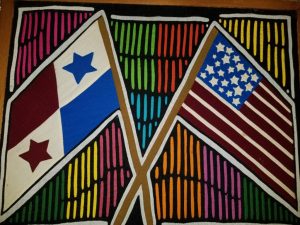
Mola folk art of the indigenous Guna people of Panama.
(SPECIAL THANKS TO MY COUSIN XENEIDA FOR INSPIRING THIS ARTICLE. TE QUIERO MUCHO, PRIMA!)
First, let me state for the record that I was born in a hospital in Queens, New York in the U.S. of A, and I have the long form birth certificate to prove it, so no need to open that link to ICE’s online tip form. Now that we’ve cleared the air, I will also mention that my parents were immigrants to the United States from Panama. Their grandparents were immigrants to Panama from various different countries around the turn of the 20th century. The impetus for these immigration journeys were all the same: seeking a better life and opportunities for themselves and their family.
Many members of my family immigrated to Panama from Caribbean islands like Dominica and Grand Cayman to work on the building of the canal in the early 20th century. They were foreigners to the country. They didn’t speak the language. Some were of African heritage, and had darker skin than the European descendants and indigenous Panamanian natives. Their contribution to the workforce was integral to the completion of the canal and the economic prosperity of the country. Still, my ancestors were ostracized, discriminated against, degraded, called “chombos” (Spanish slur similar to the ‘n’ word), and largely relegated to segregated neighborhoods. There were regular calls for them to go back “where they came from” without any regard for their earned right to citizenship in Panama or the contributions they made to the country’s prosperity. Despite this adversity, they persevered. Most of the elders lived and died in Panama having learned little to no Spanish, but, if the opportunity arose, they sent their children to “Spanish” schools so they could better assimilate. As time went on, these assimilated descendants became assets to the governmental and commercial operations of Panama. The canal remained under U.S. control until 1999, and English is the universal language of commerce, so these naturally bilingual citizens held key positions in trade and government management, including working for the U.S. government and in the Canal Zone international commercial trade region. However, as time has passed, fewer and fewer of these “Zonians” (those who came to work on the Canal/in the Canal Zone) and their descendants speak English, having embraced Spanish as their sole language. I recall as a child during my yearly summer visits to Panama in the 1980s that I could all but guarantee that I could speak English to a dark-skinned Panamanian and they’d respond in kind. This comforted me and allowed me to reserve my New York accented/rusty Spanish for emergencies only. However, on my most recent visit to Panama this June after a 20 year hiatus, this was no longer the case. English is spoken far less frequently now, spurred both by the absence of the American government, and the assimilation of English-speaking immigrant groups into the Panamanian culture. Hmm…. where have I seen this phenomenon before? Maybe during my childhood attending Catholic school in Brooklyn with a bunch of Italian-American kids whose mastery of Italian was reduced to the names of culinary dishes and curse words??? But, I digress…
My family’s ability to build a life in Panama and benefit from the opportunities of employment and education allowed for the second half of my family’s immigration experience. My father was able to work and save enough money to bring himself to the U.S. to attend college at Bowie State University. He went to classes during the day and worked as a busboy at night in a DC restaurant. Although he told me this story several times, it is still impossible for me to conjure an image of my dapper, never a hair out of place, NEVER owned a pair of jeans father bussing tables. But, he did what he had to do to make a better way for himself and the family he hoped to have with my mom. She eventually came to the U.S. as well, as did her sisters and my grandmother. Most of my generation – myself, my sister, and my cousins – were born in the U.S., but embrace our Afro-Panamanian heritage con mucho orgullo (with great pride).
But wait, this is a global health blog. How does this article relate? I am glad you asked. Global implies “international,” and addresses the health issues of people from varied cultures, backgrounds, and perspectives. That is what we do here at The O’Neill Institute, and we are some of the best in the business. Our expertise is informed by the international composition of our staff. Most of us are either the children of immigrants or immigrants ourselves. We appreciate the advantages afforded to us from living, being educated, and working in the U.S., and want to return the benefits to improve the lives of others throughout the world. I can attest to the fact that I do not take my good fortune for granted. I know what my family endured to get me where I am, and I feel that I owe it to them and to those still striving to make their way to pay it forward.
The American Dream is not reserved for a selected few. Nor is it sought arbitrarily by those working to get to America or to stay here. It is a matter of life and death for some fleeing war-torn countries. It is a future for themselves and their children that their ancestors could never fathom was possible. Those who have grown up in the United States deserve to become citizens, because it is the only home they’ve known. The story of immigrants IS The American Story, because America’s strength will only endure if it learns how to embrace all people and work together on a common mission to ensure liberty and justice FOR ALL.



